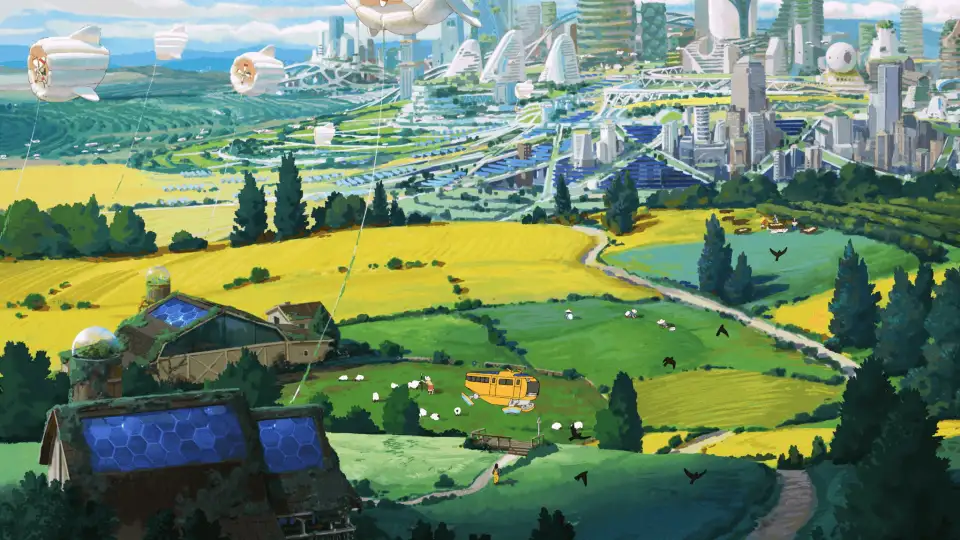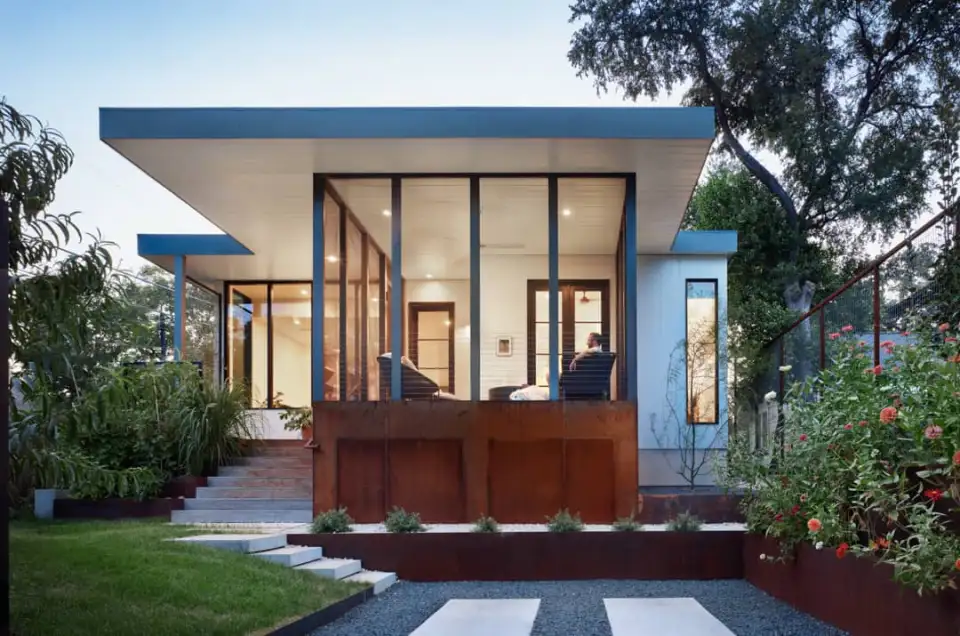
If we do not or cannot envision the future we want, how can we create it? As The Guardian’s Rebecca Solnit argues, the climate crisis is a crisis of imagination.
“There is a sad failure of imagination at the root of this crisis,” she writes. “An inability to perceive both the terrible and the wonderful…Some cannot see that the world, which has been so stable for 10,000 years, is now destabilized, and full of new perils and dangerous feedback loops. Others cannot imagine that we can actually do what is necessary—which is nothing less than building a new and better world.”
For many of us, it’s all too easy to imagine the terrible, particularly as we witness the damage caused by just 1.2°C of global heating today. We’re also bombarded by Doomist messages.
For example, Roger Hallam, the co-founder of Extinction Rebellion, recently said this of climate change: “I am talking about the slaughter, death, and starvation of 6 billion people this century. That’s what the science predicts.”
Only that’s not what the science predicts. According to the fact-checker website, Climate Feedback: “Research shows that continuing climate change results in a broad array of serious threats to humans and other species. However, counter to Hallam’s statement, published studies have not predicted 6 billion human deaths this century and there is no credible mechanism referred to justify how this could happen.”
Hallam’s not alone. According to the celebrated novelist, Jonathan Franzen: “We literally are living in end times for civilization as we know it. We are long past the point of averting climate catastrophe.”
We are so good at envisioning nightmares when it comes to imagining the future. Entertaining pop culture and aesthetic movements—like Cyberpunk, Steampunk, and Dieselpunk—fixate on apocalypse. Some of my favorite movies growing up, like Mad Max and Blade Runner, tell that story.
Is apocalypse inevitable?

In the months leading up to the United Nations (UN) Climate Change talks in Paris in 2015, the accepted wisdom was that the world was headed to about 5°C warming by the year 2100 if we didn’t change course. Today, prospects for the future look quite different. Most analyses of our current trajectory of warming, based on the economics of clean energy and the current policy environment, peg our new “business as usual” trajectory at somewhere between 2.4° and 2.7°C of warming by 2100. Climate Action Tracker says about 2.7°C. International Energy Agency (IEA) projections suggest 2.5°C. The assurance and risk management company, DNV, predicts 2.4°C in its Energy Outlook.
Of course, there is a healthy range of uncertainty around any of these projections. But it now looks highly unlikely that we’ll hit 5°C. That’s great news. It makes Hallam’s imaginings of 6 billion dead even less likely, and it puts the lie to Franzen’s declaration that it’s too late.
Still, we have a massive amount of work to do. This new “business as usual” is over twice the level of warming we’re already experiencing. The result would be tremendous human suffering and ecological damage. If we’re in a race with climate change, then we’re still in it, but it’s far from over.
But why are we still in the race? Why have we been able to revise down the “business as usual” case from 5° to 2.5°C? Certainly, the Paris Climate Accord has played a role. So, too, has the youth climate movement and climate strikes of Greta Thunberg and other youth climate activists from around the world.
One of the biggest reasons is that clean energy has defied all projections, plummeting in price at a rate that virtually no one saw coming. The exponential growth of clean energy deployment has also smashed predictions. The glaring mismatch between the yearly predictions of gradual solar energy growth by the IEA compared to the actual, exponential growth seen in the real world would be comical if IEA’s projections didn’t also provide false cover for the fossil fuel industry to attack clean energy or mislead governments about the real potential of the clean energy transition.
The cause of these cost declines and exponential growth rates in clean energy is almost as exciting as the cost declines and growth themselves: learning by doing.
“Learning by doing” sounds so commonsensical, even mundane, that it’s easy to discount as unimportant. But it has the power to change the world. Also known as Swanson’s Law or Wright’s Law, the principle is that as a technology’s deployment doubles, all of the learning and micro-innovations that go into making that deployment happen drives down the cost of that technology by a certain percentage, known as the learning rate. For the past decade, the learning rate of utility-scale solar has been a whopping 36%, meaning that each time global solar deployment has doubled, the cost of solar energy has gone down by more than a third.
This dynamic sets up a beautiful feedback loop. As more solar is deployed, the cost goes down more, which encourages more deployment, which drives cost down further, and so on. We see similar (though not quite as steep) learning rates in wind and batteries.
How does Passive House fit into this climate race? The genius of Passive House design is that it recognizes that the building itself—its skeleton and skin and how all the buildings components function together as a system—is technology. So, just as in solar and wind and batteries, we can harness the power of learning by doing. Anyone who’s been involved in more than a couple Passive House projects will tell you that learning by doing is real. You’ll hear anecdote after anecdote about how the first project that you do will be challenging, but the second gets easier (and therefore cheaper), and the third gets easier still, and so on.
It looks like we’re seeing this learning by doing with Passive House on a regional industry-wide scale, too. Data from the Pennsylvania Housing Finance Agency compares construction budgets for 268 proposed multifamily projects over a three-year period: 194 conventional buildings and 74 Passive House buildings. In year 1, there was a 5.8% cost premium for the Passive House proposals compared to conventional buildings. By year 2 that went down to 1.6%. And by year 3, there was a 3.3% savings for the proposed Passive House buildings compared to the proposed conventional buildings.
Technologies like Passive House, solar and wind energy, battery storage, and electrification are keeping us in the race.

Christina Figueres, co-host of the Outrage + Optimism podcast and the former UN Climate Chief who successfully ushered the Paris Climate Accord to completion, acknowledges both the climate destruction that we’re already experiencing, as well as the progress we’re making to bend the curve, and calls for us to hold both outrage and optimism as we work for climate action.
“By assuming one reaction or the other—outrage or optimism—we force ourselves into a box. We risk reducing our thinking and acting according to a binary mentality…The complexity of the climate crisis and its solutions mean we need to get used to holding complex emotional reactions, and to pursuing complex solutions. The path ahead will be full of outrage and optimism. We can use both of those to push for the policies we know we need.”
Maybe it’s time to lift up our heads and envision a different future from the death and starvation of Hallam and the apocalypse of Cyberpunk.
Enter the aesthetic and literary movement of Solarpunk. Solarpunk is a response to Cyberpunk. It recognizes that if we spend all of our energy imagining apocalypse, then we won’t have any left to envision the future that we actually want to build.
“Solarpunks ask ‘what kind of world will emerge when we finally transition to renewables?’”, says Jennifer Hamilton of the University of Sydney. Solarpunk recognizes that we aren’t making that transition fast enough, but it imagines what we can create when the transition finally happens.
“Solarpunk begins with infrastructure as a form of resistance,” writes Adam Flynn, author of Solarpunk: Notes toward a Manifesto. So, that protected bike lane is a form of resistance. That streetcar is a form of resistance. The high-speed rail linking cities is resistance. That multifamily Passive House building is resistance.
The Solarpunk Manifesto starts with this: “We are Solarpunks because optimism has been taken away from us and we are trying to take it back.”
Punk owns outrage. What Solarpunk is doing is keeping that outrage, but reclaiming optimism, recognizing that we need both. To create the future we want, we need to hold these two emotions simultaneously.
Though the Solarpunk movement has a distinct post-capitalist, revolutionary vibe, the creative piece that really popularized Solarpunk was an ad for Chobani Yogurt, entitled “Dear Alice”. In a scene that looks like it is straight out of a Studio Ghibli film, we see our hero, connected to the land, sipping her tea. Her bike is on the right. Some sort of high-tech farming operation is going on in that barn. Solar panels are integrated with crops in the distance. Floating wind turbines glide around like kites. A glimmering city sits in the distance.
Solarpunk art explores the coexistence of technology and nature, of cities and rewilding. You see lots of trees on buildings in Solarpunk art, which raises questions of weight, concrete, energy performance, and embodied carbon. Passive House designers and builders have contributions to make to the conception of Solarpunk architecture.
For me, Passive House already is actively Solarpunk. It’s Solarpunk, because Passive House buildings are healthy havens for people, even in the face of climate change. It reduces energy demand, which makes the clean energy transition easier. It also reduces energy load. The superior thermal envelopes of Passive House buildings act like a long-term thermal battery, sipping a bit of energy from the grid, and not stressing it. This means that the future clean grid will require fewer clean energy resources to heat and cool our Passive House buildings, which makes the clean energy transition easier, which makes a Solarpunk future possible.
And, perhaps the most Solarpunk thing about Passive House buildings is their passive resilience. These buildings provide survivable shelters even during power outages, heat domes, intense pollution events, and the other disruptions we are likely to face due to climate change.
We know we’re in a race with the climate crisis, and we should be outraged by its impacts and the efforts by far too many to slow down climate action solution-making.
But, on the climate solutions side we can accelerate virtuous circles to destroy demand for fossil fuels and put the brakes on climate change. At the heart of many of these virtuous circles is the power of learning by doing, a power that applies to Passive House design and construction. Considering that buildings are responsible for about 40% of energy-related greenhouse gas emissions globally, that is a big deal. We all have a starring role to play in building a Solarpunk future. Let’s do it!
—Zack Semke